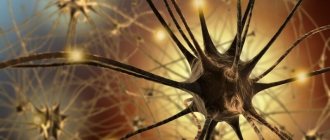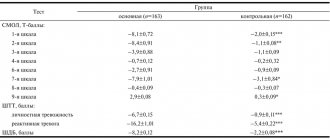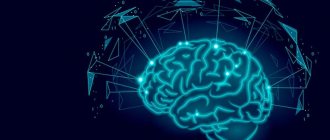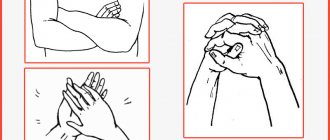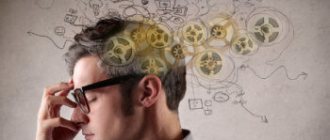The human brain is still the biggest mystery. However, thanks to the rapid development of neuroscience, we have learned to control his condition. Meditation and relaxation, developmental and intellectual exercises, neurofeedback training - all these are techniques aimed at training our brain. We tell you how it works and why it is needed. Olga Chashchina, psychotherapist, Ph.D., specialist in neurotechnology at X-Clinic, helped us understand the intricacies of this issue.
Why and when do you need to develop a child’s brain?
It is important for parents to learn how to properly develop the child’s mental abilities in order to correctly and timely stimulate the child’s cognitive interest and begin the process of learning various skills. For the development of a child's brain, exercise is necessary, without which synapses - neural nodes - will not form. If you do not repeat a memorized poem from time to time, it may be forgotten over time. The same thing happens with synapses, which, if left idle, weaken, and, in the end, can completely collapse if exercises for brain development are not used. Until the age of 10, the work of a child’s brain absorbs a huge amount of energy - much more than what the adult brain requires. Given this activity, children need to do brain exercises as often as possible. Ordinary life situations are best suited for this. The introduction of educational moments into games is all the more important, since it is known that a child will never perceive information conveyed in the usual way as deeply as that which came to him in the context of experienced emotions.
What is dementia
With the development of dementia, a person’s mental abilities decrease, existing knowledge and skills are gradually lost, and the ability to learn is lost.
Thinking, orientation, understanding, counting, learning, language and judgment are impaired. There are many reasons why dementia develops. Dementia can be triggered by endocrine and vascular pathologies, depression, certain infections, traumatic brain injuries, brain tumors, alcoholism and drug addiction. Additional risk factors for developing dementia include:
- heredity. Moreover, the risk increases if the pathology in close relatives developed before the age of 65 years;
- obesity;
- lack of active intellectual activity.
The work of the brain hemispheres
The right and left sides of the brain work together. For the best solution to a problematic issue, their coordinated activity is required: highlighting the most important points, analyzing them, creating an overall picture, searching for a way out with minimal losses. It often happens that a non-standard idea that arose spontaneously is the only correct solution. To understand how the brain works, you need to clarify which hemisphere is responsible for what.
The left hemisphere controls:
- mastery of facts;
- speech skills, reading, writing;
- processing, memorization and structuring of linguistic information;
- handling numbers and mathematical concepts;
- analysis and step-by-step logic;
- planning.
The right hemisphere controls:
- image processing and storage;
- intuitive thinking and spatial orientation based on it;
- creative potential;
- imagination;
- the ability to perceive metaphorical images;
- sense of humor.
When a child performs one action or another, his brain switches activity from one hemisphere to the other. In the case of combining intuition with logic, a balance between the hemispheres is maintained and the most creatively active work occurs, allowing the intellect, without fear of failures and mistakes, to achieve the highest results.
First signs of dementia
- Both long-term and short-term memory are impaired. It becomes difficult for a person to remember events that happened recently or remember new information.
- A person loses the skills of orientation in space and time. It is not uncommon for patients to become lost even in areas familiar to them.
- Indifference to once-loved activities appears, and the desire to learn new things disappears. This happens because the brain is no longer able to receive and process information.
- Reducing the criticality of one's own perception. Usually this symptom appears when planning the next period of life.
- In the future, both the progression of these symptoms and the appearance of others, more powerful in their effects, are noted. One of the clear hallmarks of dementia is that a person lives in his past.
At the earliest manifestations of the disease, it is important to promptly consult a therapist or general practitioner. If necessary, he will refer the patient to a specialist (neurologist, psychiatrist or geriatrician).
Checking the hemispheres: which is more developed?
It is not at all difficult to check which type of thinking predominates in a child - logical or intuitive. There is no need for physical devices here; the body functions themselves will give the answer. Each hemisphere controls a different side of the brain. The side that is dominant will indicate the dominant hemisphere. The child should be asked to do the following:
- put your palms together, interlace your fingers and extend the “lock” forward, paying attention to which thumb is on top;
- applaud by turning your hands horizontally and seeing which palm is on top;
- Cross your arms over your chest and see which one will be on top.
There are many other ways to determine the “side” of thinking. For example, “a spinning girl,” where you need to imagine in which direction she is spinning. Interestingly, her pose allows her to rotate in both directions. If both hemispheres are developed harmoniously, then the choice can fall in both directions. But even if the imagination gives preference to one type of rotation, then there is nothing to worry about. There are many exercises and techniques with which you can comprehensively train your brain.
A few more tips
1.If you are right-handed, from time to time perform your usual rituals with your left hand. And vice versa. For example, use your other hand to brush your teeth or use this technique during breakfast or lunch.
2.Another useful exercise is to take a shower or perform other normal activities with your eyes closed.
3. When getting to work, the store and other places, change your route regularly.
4. Try watching films without sound from time to time, and try to understand what is being said by the actors’ gestures and movements.
Exercises to develop both hemispheres of the brain
There are several effective methods that are suitable not only for children, but also for adults. Brain training exercises balance the hemispheres through physical activity of the body and emotions.
"Ear and Nose"
You need to touch the tip of your nose with your left hand, and with your right hand grab your left ear. After clapping your hands, change the position of your hands to the opposite. Many adults are not able to do this exercise at first, which makes children happy.
"Wave"
Rhythmically clench your right hand into a fist, and at the same time depict a wave with your left. Then change movements between hands. How many times will the fist make a wave?
"Pet yourself"
This exercise was previously used in elementary schools during five-minute exercises. You need to tap the top of your head with your right hand, and stroke your stomach with your left. You can make the exercise more difficult by lifting your leg and rotating it, and then quickly change the movements of your arms and leg.
"Cross Movements"
Touch your left heel with your right hand, and then touch your right heel with your left hand. Then change movements - right hand to the right heel, and accordingly the left. Perform the last exercise at least 6 times, then return to cross touches and gradually increase the speed of execution, trying not to lose track
A good exercise for the fingers, training their fine motor skills and the corresponding parts of the cerebral cortex. The thumb should be connected in turn into a ring with the index finger, then with the middle, ring and little fingers. First you need to train one hand, then the other, and then try to work with both hands at once, moving your fingers as quickly as possible.
"Conductor"
To perform it, you need to imagine yourself as an orchestra conductor, turn on familiar music, and raise both hands to shoulder level - one slightly higher than the other. In this position, begin to draw a figure eight in the air: with your right hand from the middle of the figure to the right and up, and with your left to the left and up. Then repeat the movement in reverse order. Sports juggling develops manual dexterity, attentiveness, activates both types of thinking, and trains the intellect. Children develop creatively and become confident in their abilities.
"Mirror Drawing" or "Double Doodles"
During this exercise, both hands (or legs) simultaneously draw mirror figures. With its help, the transition from gross to fine motor skills is facilitated, the skill of following instructions is developed, concentration is trained, and writing, reading, mathematics and spatial perception skills are improved. Draw on an easel or board at the same time with both hands, armed with colored felt-tip pens, like mirrored figures. The hands must make synchronous movements: now one towards the other, now diverging, now up, now down, and curious figures will appear on the board. You can stand behind the child to help him, guiding his hands. Let him learn to make movements from the sternum, the midline of the body. You need to give commands out loud: “up”, “to the side”, “down”, “towards the center”, so that he draws circles, squares, triangles and other shapes with both hands at the same time. Then he must continue this activity on his own after he learns to easily draw “mirror figures.” Having started drawing on a large board, the child should then try to repeat it on a small piece of paper. You can draw with anything - markers, pencils, paints, chalk.
In the early stages of dementia, the following factors are important:
For a person with dementia, it is important to create a quiet, homely, familiar atmosphere. Moreover, the circle of people with whom he communicates must be constant. This will eliminate feelings of anxiety, nervousness, confusion and excitement. It’s a good idea to create a daily routine and stick to it strictly.
Lyudmila Zhilevich: “Unfamiliar faces, new situations that a person is no longer able to remember, can provoke an acceleration of the development of the disease, and also negatively affect his condition.”
The first symptoms of dementia are not a reason to give up exercise. This could be walking in your favorite places, simple work in the garden, physical therapy exercises (at least 150 minutes of anaerobic exercise weekly).
Life should be full of various events and types of intellectual activity. You can read, solve crosswords and scanwords, play chess or checkers, discuss past cultural or political events.
It is important for the patient to have a hobby, but it should not only be a source of positive emotions and bring pleasure, but also stimulate cognitive and mental abilities.
A sick person's diet should contain foods that lower cholesterol levels. For example, barley, legumes, blueberries. Instead of butter, it is better to give preference to vegetable oil. The menu can include fermented milk products, lean meats and poultry, lean fish, seafood, and sauerkraut. To improve the taste of dishes, the use of seasonings (sage, cinnamon, turmeric, saffron) is allowed. But it is better to reduce salt consumption to a minimum. You should definitely drink the daily amount of clean water (at the rate of 30 ml per 1 kg of weight). It is better to cook by steaming, you can bake or boil.
If you follow all the doctor’s recommendations, you can slow down the progression of the disease, which means significantly improving the patient’s quality of life and delaying severe manifestations of dementia. At the same time, people who have a hereditary predisposition to developing the disease should pay special attention to prevention: lead a healthy lifestyle, do exercises daily for mental exercise, and control blood cholesterol levels.
An important point is to create comfortable conditions so that a person suffering from dementia remains independent for as long as possible. The best therapy is to spend more time with elderly relatives, surround them with love, care, and help them feel useful and needed, the specialist added.
Exercises to train the right hemisphere
The right side of the brain is responsible for a holistic perception of reality, creativity, and intuitive knowledge of reality. To develop this hemisphere, you can use: visual images, listening to music, drawing, meditation, immersion in dreams, in other words, any actions that operate with holistic images. The following activities are effective for developing the right hemisphere: dancing, singing, writing poetry and other literary forms (for example, in the form of a diary). Any type of activity related to functions for which the right hemisphere is responsible is suitable. Recently, special courses on “right-hemisphere drawing” have appeared. When copying images, a special technique is used here, with the help of which the child moves away from stereotypical, template thinking, trying to depict the object on the canvas as realistically as possible. With the help of such activities, the boundaries of consciousness are expanded, a new perspective appears on familiar things, the world around us is assessed from a different perspective, and imagination develops.
Dream
Sleep is one of the most important factors for healthy brain function. The following points can be highlighted:
- There should be enough sleep. On average, this is 7-8 hours of sleep without waking up
- Going to bed should be such that you can fall asleep within 15 minutes of being in bed.
- Sleep should be in a decent environment. Fresh air, darkness, silence are desirable.
- Sleep should coincide with a person's internal clock (usually starts before 12 am and ends at 6-10 am).
I try to sleep 8-10 hours and get up early in the morning.
Exercises to train the left hemisphere
The more “mathematical” left hemisphere deals with calculations and analysis. The best types of exercise for him are studying the exact sciences, including solving mathematical problems. The greater the number of tasks and the more complex they are, the more developed the left hemisphere becomes. This includes solving crossword puzzles, puzzles, and sudoku. In these classes, analytical thinking, located on the left side, works, which is why she trains more. If parents know how to develop both hemispheres of the child's brain, then they can make the learning process fun, which will help the child improve more effectively. By doing simple brain development exercises, the whole family can have an interesting and fun time. Later, it will not be difficult to notice how much more balanced, attentive, happy and healthy the child has become - and isn’t this a success?
Nutrition
The brain is an extremely energy-demanding organ.
Therefore, nutrition should be uniform throughout the day and include very special substances. They are many and varied, but in general, proteins, complex carbohydrates, and omega-three fats are recommended. For example, my breakfast usually consists of an apple and scrambled eggs (sometimes with pieces of fish), lunch - from vegetables/fruits and meat, dinner - also from vegetables and meat. I also take vitamins every day, drink a lot of water (about 2-3 liters) and 2-4 mugs of green tea. Here it must be said that nutrition and brain function are directly related. If you do other things while eating, the food will not be absorbed, since for complete assimilation you need to perceive food with all your senses and allow your brain to focus on this difficult process.
Also, if you eat a lot at once, the brain will not properly receive energy and work smoothly. You can compare it to a fire - either you keep the fire even by adding wood little by little after a certain amount of time; or you wait until everything burns, then again throw a pile on top of the coals and light the fire again, wasting extra time and having an unequally distributed flame over time.
Plus, as I'll write later, a healthy diet makes it easy to exercise, which is great for the brain.
Therefore, you need to be very careful about nutrition - you need to keep the amount of food at one time small, and the food itself should fill you with energy evenly throughout the day.
Physical exercise
They say harmony is the absence of imbalance.
In this case, we are talking about the fact that the best rest for the brain is a change in the type of activity, for example, a change from mental activity to physical activity. I have a setting in Ubuntu that locks the computer for ten minutes every fifty minutes, and I have to go and take a walk. (a ratio of around 10-50 has been established by science and is recommended for those working at a computer). Every evening I try to walk in the fresh air for at least half an hour, or go for a bike ride (1-1.5 hours). I also like to do push-ups between activities and work with dumbbells. In addition, physical exercise throughout the day plays the following roles. Firstly, as a means to keep the body active - physical activity raises body temperature, and the brain works better. Secondly, it relieves psychological stress - it is known that suppressed emotions turn into clamps in the body, physical activity and sports relieve this along with stress, and so on. Thirdly, regular physical activity leads to the production of endorphins - hormones of joy and happiness - and thus the person who exercises improves his mood throughout the day. That’s why, by the way, exercise is so invigorating—it gets the blood pumping, as they say.
There is a lot more. For example, by switching over and going for a walk, you give a task to your subconscious, which will solve it better than you. In addition, regular physical activity keeps your body in good tone and allows you to look as slim as you decide.
Thus, a regular combination of normal activities at the computer with various types of physical training dramatically increases the efficiency of work and life in general.
On my own, by riding regularly for at least 5 hours a week, doing various physical activities, and quitting drinking alcohol altogether, I was sick for only 1 week during these six months. Against at least a month earlier.
Get out of your comfort zone
When you feel comfortable and happy, your brain releases chemicals that make you feel good. But in the long run, comfort does not benefit him.
It is the willingness to step out of your comfort zone that keeps the brain young. Seek new experiences, develop new skills, and be open to new ideas.
Without mental work, dendrites - the processes of neurons that conduct nerve impulses to the body of the neuron - shrink or disappear completely. Living an active life increases dendritic networks and the brain's regenerative capacity, known as plasticity.
When you step out of your comfort zone, you stretch your brain and your dendrites grow like trees with many branches.
Perception of the world
The brain perceives the world in a distorted form, and this is very important to know and constantly know.
The picture of squares at the beginning of the article is an example of this. However, distortions in perception at the level of consciousness are much stronger (I already wrote about this in the article “Models of reality and their role in people’s lives”). In fact, these distortions are the cause of much conflict and misunderstanding throughout the world. That is why it is important to always question both the facts and truths coming from the outside, as well as your own beliefs and ideas about the world and yourself.
For me personally, the following incident was a revelation. I always considered crows to be cunning, and, seeing these birds, I looked for and found something cunning in their behavior. One day, passing by several birds, I looked into the eyes of a crow - and did not find anything cunning there, nothing human; only an incomprehensible feeling remained. And I realized that by endowing an object with some properties in my consciousness, I began to see it the same way in reality. Since then, I have been trying to constantly re-evaluate people, understanding that current perceptions may be wrong.
This consideration can be made to work for you in the following way. Realizing that you can control your perception of reality, and that it will always be incomplete, shape it to your liking. Take what you don’t like - people, work, home, and so on - then find the positive aspects, and strive to continue to perceive events related to the phenomenon under consideration only in a positive way. And, having convinced yourself that what is happening is positive and useful in some sense (even learning to joke about this topic), you will notice how your attitude will begin to change to a positive one - previously unloved people will begin to like them, respect for them will appear; tedious tasks will arouse interest and sparkle with new colors.
And if you fail to look positively, again, you have the power to change not only the model of the phenomenon in your brain, but also reality. Just change what is annoying to what is desirable - yes, you will have to make an effort, but it is worth it. That’s why I quit smoking and drinking - it was becoming increasingly difficult to find positive moments, and losses in the form of money, health, and time were obvious and negative for my life.
As a result, we can say that the constant and active development of new fields of activity comprehensively affects a person in a positive way - both on his worldview, respect for himself, for his personality, awareness of his versatility, and on the brain, which generously thanks for what he is presented with new food for the mind, as they say.
Keep a diary
Keeping notes will help you prioritize, think clearly, and focus on important things instead of urgent ones. A diary also helps Effects of Expressive Writing on Psychological and Physical Health cope more easily with stressful situations and anxiety and even increases Effect of Written Emotional Expression on Immune Function in Patients With Human Immunodeficiency Virus Infection the activity of immune cells.
“Keeping notes improves the brain's ability to perceive, process, store, and retrieve information,” explains neurologist Judy Willis. “This develops long-term memory, helps to notice patterns of thinking, and gives time for reflection. And with the right approach, it becomes a source of conceptual development and stimulates the higher mental functions of the brain.”
Literature
I read a lot, but from the books you can always single out those that influenced me the most.
- Robert Anthony, The Secrets of Self-Confidence.
 The book, after which I stopped drinking, moved out from my parents, and in general my hair became smooth and silky. Seriously, the book in terms of density of useful information and detail was in some ways comparable to “The Perfect Code” for me. It contains recipes for uprooting almost all types of cockroaches - low self-esteem, feelings of guilt, subjectivity and judgment of other people, fears, feelings of loneliness, and so on.
The book, after which I stopped drinking, moved out from my parents, and in general my hair became smooth and silky. Seriously, the book in terms of density of useful information and detail was in some ways comparable to “The Perfect Code” for me. It contains recipes for uprooting almost all types of cockroaches - low self-esteem, feelings of guilt, subjectivity and judgment of other people, fears, feelings of loneliness, and so on. - Matthew McDonald, Train Your Brain to Work. Scientific basis for many points that I read about in other books and articles, incl. Anthony's books. Everything is detailed and tasteful.
- Timothy Ferriss, How to Work 4 Hours a Week. I was infected with optimism, approach to life, and just an attitude towards time management.
A list of three books, in fact there were hundreds of them. Even in the science fiction of Asimov and the works of Hesse, there is always something that you can think about and change in yourself or the world around you.
I wish you success!

